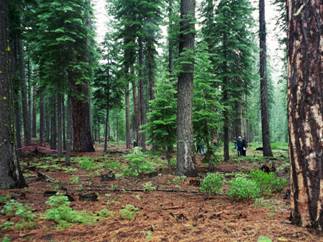Mitigating Climate Change Through Forest Carbon Sequestration
By Bill Buchholz
Protecting forests and forest ecosystems has been a challenge for environmentalists for decades. Forests store an enormous amount of carbon, but we use some of that carbon for wood and paper products that make our life what it is today. The challenge is in striking a healthy balance between our need for wood and paper products, and protecting forest ecosystems. Today we have an additional challenge of managing forests to maximize carbon sequestration.
Forests contain far more carbon than is commonly believed. It is estimated that at least half of the carbon in a forest is below ground, stored in tree roots and soil. The half that we see above ground is split approximately equally between a tree’s trunk, and its branches and leaves. So when a timber company cuts down a tree, they are only using the carbon in the tree’s trunk, while the remaining 75% immediately begins to decompose and release its carbon into the atmosphere. Cutting down dead trees is not much better - this only accelerates the rate of decomposition and carbon emissions, while disrupting a naturally changing ecosystem.
see above ground is split approximately equally between a tree’s trunk, and its branches and leaves. So when a timber company cuts down a tree, they are only using the carbon in the tree’s trunk, while the remaining 75% immediately begins to decompose and release its carbon into the atmosphere. Cutting down dead trees is not much better - this only accelerates the rate of decomposition and carbon emissions, while disrupting a naturally changing ecosystem.
One strategy for increasing the amount of carbon sequestered in forests is to allow trees to grow longer before being cut down. The industry’s claim that young trees sequester carbon at a faster rate than old trees is false. In 2009, professor Steven Sillett, the world’s leading authority on redwoods, refuted the assumption that redwood trees grow more slowly as they age. In fact, he found the opposite was true!
A global study recently published in the journal Nature also confirmed this fact. Researchers from the U.S. Geological Survey and Oregon State University reported that 97% of 403 tropical and temperate tree species grow more quickly the older they get. The study included repeated measurements of over 673,000 individual trees on six continents, going back over 80 years. They concluded that rapid growth in giant trees is the global norm. In human terms, it is as if our growth just keeps accelerating after adolescence, instead of slowing down! Yale School of Forestry researchers came to a similar conclusion, saying that it is possible to increase carbon sequestration by managing forests for maximum sustained yield - not for maximum financial profit.
Perhaps the most important strategy for increasing the amount of carbon sequestered in forests is to stop the timber harvesting practice known as clearcutting. Clearcutting exposes the soil to drying in the sun which kills soil organisms, releasing large quantities of carbon into the atmosphere. University of New Mexico scientists and other researchers conclude that there is enormous potential for carbon sequestration in soil. They found that soil which is not exposed to drying out in direct sunlight retains its carbon, and can hold up to 30% more water. Retaining moisture in the soil is also an effective strategy for combating the effects of drought. Managing forests using selective thinning techniques (uneven-aged forest management) protects the forest floor from carbon loss due to drying, provides more precious water for trees, reduces fire fuel loads, preserves ecosystems, and protects California’s watersheds and fisheries from degradation due to erosion.
The State of California has yet to implement these strategies. In 2010, the Air Resources Board (ARB), the agency charged with monitoring and regulating greenhouse gas emissions, concluded that since the state’s forests are a net sequesterer of carbon dioxide, that nothing needed to be done to improve the way forests are managed until after 2020. However, the recent Paris Climate Talks (COP21) formally recognized the role of healthy forests in addressing climate change and urged taking immediate action.
Assembly Bill AB-1504, which passed in 2016, takes a step in the right direction but doesn’t go far enough. It amended the Forest Practice Act of 1973 which regulates timber harvesting by including a requirement that sequestration of carbon dioxide should be considered when managing forests. Other requirements include protection of watersheds, fisheries, wildlife, and recreational opportunities. The law specifically states, “The board, the department, and the State ARB should strive to go beyond the status quo sequestration rate and ensure that policies and regulations reflect the unique role forests play in combating climate change.”
The State’s Forest Climate Action Team (FCAT) recently issued a draft Forest Carbon Plan to look at this issue of carbon sequestration in California forests. On February 16 they held their first public workshop with comments coming from Sierra Club members, environmental groups, industry representatives, and state and local agencies. Many of the comments had to do with the plan’s lack of specificity and implementation. But if we are serious about addressing climate change, then we should insist that California forests are managed to optimize their potential for carbon sequestration. Comments on the draft Forest Carbon Plan are welcome until March 17, 2017.
Author bio:
Bill Buchholz is a member of the chapter’s Forest Protection Committee, Soils Committee, and the Club’s national Forest Certification and Green Building Team
Make A Difference
Visit the Club’s “Stop Clearcutting California” website and sign our petition
o Comment on the State’s Forest Carbon Plan
o Buy FSC-certified wood and paper products (http://lomaprieta.sierraclub.org/forestprotection)
o Buy recycled wood and paper products
o Avoid products containing palm oil
To Learn More
Recommended reading:
“The Hidden Life of Trees - What They Feel, How They Communicate” by Peter Wohlleben
“The Wild Trees” by Richard Preston